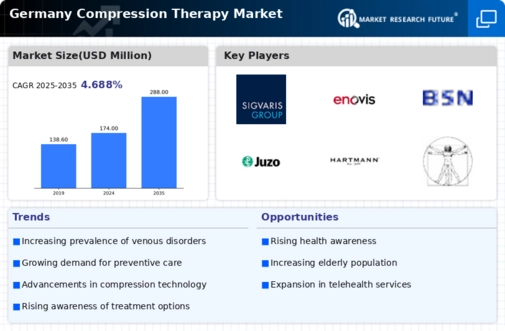Growing Healthcare Expenditure
Germany's increasing healthcare expenditure is a significant driver for the compression therapy market. With healthcare spending projected to reach €500 billion by 2025, there is a growing emphasis on preventive care and effective management of chronic conditions. Compression therapy is recognized for its cost-effectiveness in reducing complications associated with venous disorders, thereby appealing to both healthcare providers and patients. The German government’s commitment to improving healthcare access and quality is likely to facilitate the adoption of compression therapy solutions. As reimbursement policies evolve to cover more innovative treatment options, the market is expected to witness substantial growth, reflecting the broader trends in healthcare investment.
Supportive Regulatory Environment
The regulatory environment in Germany is becoming increasingly supportive of the compression therapy market. The German Medicines Agency (BfArM) and other regulatory bodies are establishing clear guidelines for the approval and use of compression therapy products. This regulatory clarity fosters innovation and encourages manufacturers to develop new and improved products. Additionally, the emphasis on quality standards ensures that patients receive effective and safe treatment options. As regulations evolve to support advanced compression technologies, the market is likely to benefit from increased product availability and consumer trust. This supportive framework is essential for the sustained growth of the compression therapy market.
Advancements in Compression Technology
Innovations in compression technology are transforming the compression therapy market in Germany. The introduction of smart textiles and adjustable compression garments enhances patient compliance and treatment efficacy. For instance, devices that monitor pressure levels and provide real-time feedback are becoming more prevalent. This technological evolution not only improves the effectiveness of treatment but also attracts a younger demographic that values convenience and innovation. The market for compression therapy products is projected to grow at a CAGR of approximately 6% over the next five years, driven by these advancements. As manufacturers invest in research and development, the availability of high-quality, technologically advanced products is likely to increase, further stimulating market growth.
Increasing Incidence of Chronic Venous Disorders
The rising prevalence of chronic venous disorders in Germany is a crucial driver for the compression therapy market. Conditions such as varicose veins and chronic venous insufficiency affect a significant portion of the population, with estimates suggesting that around 25% of adults may experience some form of venous disease. This growing patient demographic necessitates effective treatment options, thereby propelling the demand for compression therapy solutions. As healthcare providers increasingly recognize the benefits of compression therapy in managing these conditions, the market is likely to expand. Furthermore, the aging population in Germany, which is projected to reach 23 million individuals aged 65 and older by 2030, further exacerbates the need for effective compression therapy interventions.
Rising Demand for Non-Invasive Treatment Options
The shift towards non-invasive treatment options is becoming increasingly pronounced in the German healthcare landscape, significantly impacting the compression therapy market. Patients and healthcare providers alike are favoring treatments that minimize surgical interventions and associated risks. Compression therapy is viewed as a safe and effective alternative for managing various venous disorders, which aligns with the growing preference for conservative treatment methods. This trend is likely to be reinforced by patient education initiatives that highlight the benefits of non-invasive therapies. As awareness of these options increases, the demand for compression therapy products is expected to rise, contributing to market expansion.


















Leave a Comment